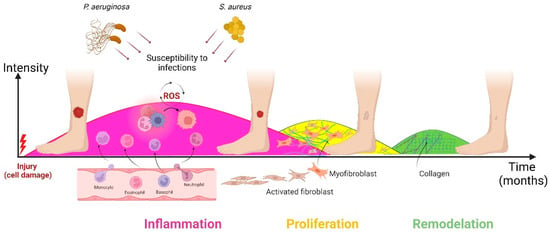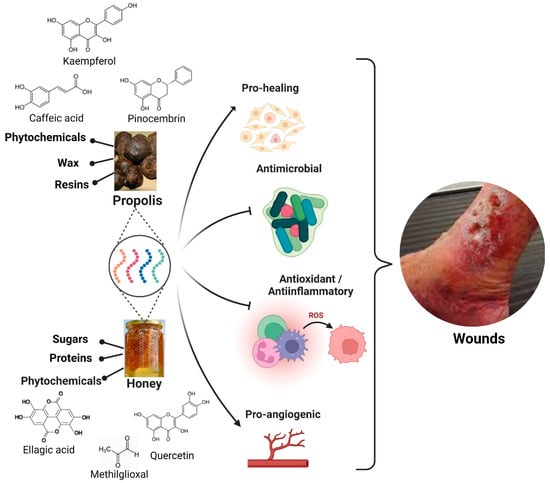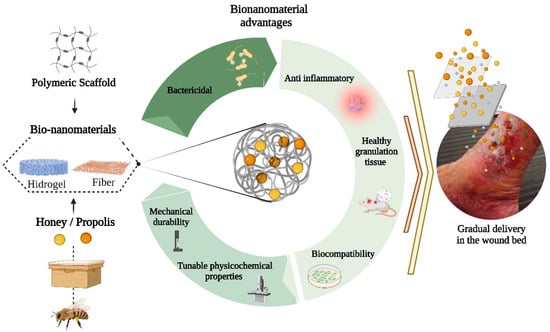Wound healing is a public health concern worldwide, particularly in chronic wounds due to delayed healing and susceptibility to bacterial infection. Nanomaterials are widely used in wound healing treatments due to their unique properties associated with their size and very large surface-area-to-volume ratio compared to the same material in bulk. The properties of nanomaterials can be expanded and improved upon with the addition of honey and propolis, due to the presence of bioactive molecules such as polyphenols, flavonoids, peptides, and enzymes. These bionanomaterials can act at different stages of wound healing and through different mechanisms, including anti-inflammatory, antimicrobial, antioxidant, collagen synthesis stimulation, cell proliferation, and angiogenic effects.
1. Wound Healing
Wound healing has four stages, but here,
rwe
searchers describe bionanomaterials applications on three of them: inflammation, proliferation and remodeling, a period that ranges from the injury or trauma to the closure and complete healing of the wound in a time of days (acute wounds) or months (chronic wounds) (
Figure 12)
[1][30]. In the inflammatory stage, the action of lymphocytes, neutrophils, macrophages and platelets is highlighted, accompanied by the secretion of proinflammatory factors; in the proliferation stage, extracellular matrix synthesis, fibroplasia, angiogenesis, and re-epithelialization take place by fibroblasts, keratinocytes, and endothelial cells
[2][31]. Finally, in the remodeling stage, extracellular matrix synthesis initiates wound closure and contraction, by the action of myofibroblasts
[3][32].
Chronic wounds are increasing as a result of a rise in the prevalence of chronic diseases such as diabetes, cancer and cardiovascular alterations
[4][33]. An unhealed wound on a foot or leg can lead to amputation. Furthermore, chronic wounds have a microenvironmental imbalance, particularly those that are infected
[5][34].
Figure 12. Healing stages of chronic wounds. The migration of phagocytic neutrophils and macrophages to the wound site initiates the inflammatory phase and leads to the release of more cytokines
[6][35]. Oxidative environment due to the continuous production of reactive oxygen species (ROS) and prolonged pro-inflammatory phase promotes infections, and hypertrophic scars with collagen fibers in disorderly arrangement
[7][8][36,37]. Created with
BioRender.com.
2. Honey and Propolis Properties
Since ancient times, honey and propolis have been used for different purposes in medicine
[9][38], particularly highlighting their effect as pro-healing, antimicrobial, antioxidant, anti-inflammatory and pro-angiogenic
[10][11][12][6,39,40] (
Figure 23).
Figure 23. Properties of honey and propolis described for wound healing applications [10][11][12]. Created with Properties of honey and propolis described for wound healing applications [6,39,40]. Created with .
2.1. Honey
Honey is an oversaturated solution of carbohydrates resulting from the digestive process of nectar collected from flowers and stored in the cells of the hive. It is mainly composed of monosaccharides such as fructose and glucose as well as disaccharides such as maltose, sucrose, among others. Furthermore, it has enzymes such as amylase, peroxide oxidase, catalase, and acid phosphorylase; moreover, it contains amino acids, vitamins, and antioxidants
[13][41]. However, honey constituents are rather variable and depend primarily on its floral source; seasonal and environmental factors can also affect its biological properties
[14][42]. Although not all honey has the same antimicrobial efficacy, to date, no microbial resistance has been associated with the use of honey, highlighting their useful potential
[15][16][43,44]. To obtain improved properties, honey has been blended with different scaffolds at the nanoscale
[17][18][45,46]. Furthermore, the commercial use of honey bionanomaterials is suitable for treatment at any healing phase
[16][18][44,46].
2.1.1. Antimicrobial Property
Honey is a natural antibiotic, efficient against resistant microorganisms and bacterial biofilms
[19][47]. The antibacterial property of honey is due to its high osmolality, acidity, and content of glucose oxidase
[20][24]. In addition, honey has been found to be effective against bacteria in biofilm, which is defined as the presence of communities of microorganisms in the wound bed that threatens the physiological healing process as the bacteria become 1000 times more resistant
[15][43]. In particular, manuka honey has the power to act against biofilms due to methylglyoxal, which regulates fibrinogen formation and prevents the formation of biofilm structures in the wound bed
[16][44].
2.1.2. Anti-Inflammatory Property
The use of honey in wound treatments is suitable due to its anti-inflammatory activity and antioxidant capacity
[21][48]. It eliminates free radicals, thus reducing prostaglandin levels, and acts as a vasoconstrictor, and therefore, inflammation, edema, and exudate in wounds decrease
[22][23][10,49].
2.1.3. Debriding Property
Honey contains several proteases that activate the plasminogen pathway, removing unhealthy tissue from a wound. These proteases become active due to the presence of hydrogen peroxidase in honey
[24][50].
2.1.4. Tissue Regenerative Property
Honey promotes epithelial growth, speeding up the healing process and tissue regeneration. In this regard, several clinical investigations found that honey can cure chronic ulcers in a short time
[7][36].
2.2. Propolis
Propolis is a potent adhesive resinous substance, resulting from bee mastication of natural resins, which are collected from cracks in the bark and leaf shoots
[8][37]. After adding salivary enzymes during chewing, bees add beeswax to enhance its final composition. Propolis contains resins (50%), wax (30%), essential aromatic oils (10%), pollen (5%), and other substances (5%), although its composition varies significantly according to the season and flower origin
[25][51]. Propolis use for wound healing is due to the following properties:
2.2.1. Antimicrobial Properties
Antimicrobial properties of propolis against Gram(+) and Gram(−) bacteria, protozoa, fungi, and viruses are due to its flavonoid content (pinocembrin, galangin, and pinobanksin, among others)
[15][26][43,52].
Some of the most common constituents found in propolis, mainly quercetin and naringenin, promote an increase in membrane permeability and decrease in membrane potential, reducing bacterial resistance to antibacterial agents
[27][53]. Moreover, flavonoids present in propolis reduce bacterial motility due to RNA polymerase inhibition
[23][49].
2.2.2. Antioxidant and Anti-Inflammatory Properties
Propolis has shown to trap free radicals, a mechanism by which it exerts its antioxidant potential
[5][34]. Propolis also showed anti-inflammatory effects against chronicle and sharp models of inflammation. Rossi et al.
[28][54] stated that propolis prevents cyclooxygenase activity in a concentration-dependent manner due to the presence of carvacrol, a monoterpenoid that acts as a potent activator of the TRPV3 (Transient Receptor Potential Subtype V3) and TRPA1 (Transient Receptor Potential Subtype A1) ionic channels. These channels are capsaicin receptors that play a key role as a mediator of inflammatory pain
[28][54].
2.2.3. Wound Healing Property
Propolis improves the growth of skin cells and its ability of remodeling and stimulates re-epithelialization via collagen expression, regulation of ECM components, and expression of transforming growth factor-β (TGF-β)
[29][55]. This process involves the migration, proliferation of epidermal cells and keratinocytes, fibroblasts adherence, and contraction of ECM
[30][56].
3. Bionanomaterials Based on Honey and Propolis
In recent years, enormous research efforts have been allocated to develop therapeutic systems for wound treatment. The bionanomaterials have demonstrated great performance for the effective treatment of wounds in vitro and in vivo
[31][32][33][57,58,59]. The great surface area/volume ratio allows it to act as an active or passive carrier for delivering therapeutic agents
[34][35][36][37][2,60,61,62]. In this way, the advantages of bionanomaterials based on honey and/or propolis blended with polymer scaffolds can improve their bactericidal, anti-inflammatory, and stimulation of healthy granulation tissue without decreasing their mechanical or physicochemical performance
[37][38][39][62,63,64] (
Figure 34).
Figure 34. Advantages of bionanomaterials for wound healing. Honey and/or propolis blended with polymer scaffolds at the nanoscale improve the response rate of this therapy by modulating the wound microenvironment or by improving the penetration of multiple phytochemicals and other components of honey and propolis in the wound bed. Created with
BioRender.com.
Furthermore, bionanomaterials have also been reported to enhance their efficacy and reduce their negative effects in comparison with their macrosized counterpart or with the application of honey or propolis alone
[37][39][40][41][28,62,64,65].



